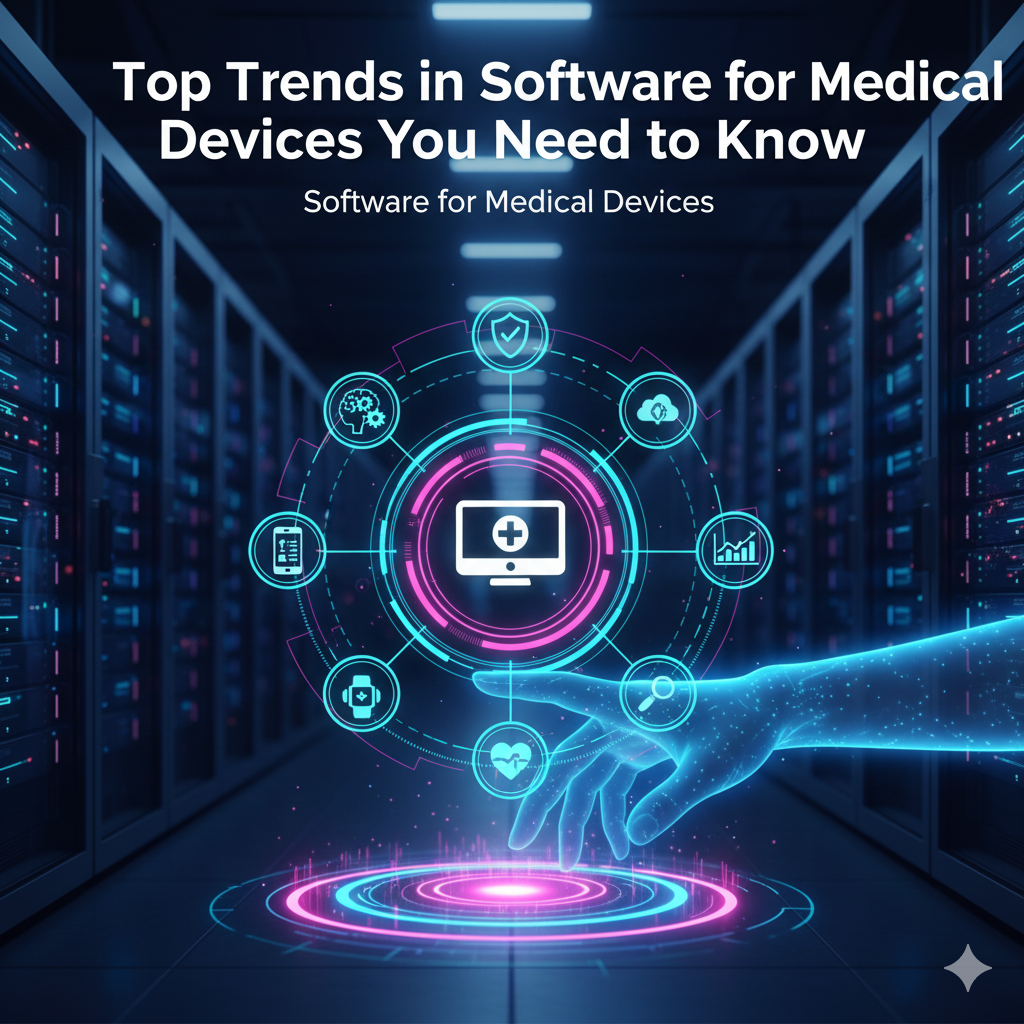
Introduction
The healthcare industry is evolving at an unprecedented pace, driven by rapid advances in digital technology and growing patient demand for smarter, more connected care. At the center of this transformation is software for medical devices—the digital intelligence powering everything from wearable monitors to complex diagnostic platforms.
In 2025 and beyond, Software for Medical Devices isn’t just about functionality; it’s about innovation, safety, interoperability, and user experience. Whether you’re a manufacturer, healthcare provider, or digital health startup, understanding the latest trends in this space is key to staying competitive and compliant.
Below, we explore the top trends in Software for Medical Devices development that are shaping the future of digital healthcare.
1. Artificial Intelligence and Machine Learning Integration
Perhaps the most disruptive trend in recent years is the rise of AI and machine learning (ML) in medical device software. These technologies are no longer experimental—they’re integral to the design of diagnostic and therapeutic systems.
AI-enabled algorithms are improving image recognition in radiology, automating ECG interpretation, and predicting patient outcomes based on real-time data. Machine learning models can also personalize treatments, adapt to individual patient patterns, and help clinicians make data-driven decisions faster than ever.
However, the challenge lies in regulatory validation. Developers must demonstrate algorithm transparency, traceability, and clinical efficacy to meet FDA and EMA requirements. As AI becomes mainstream, expect new standards to emerge for the validation and lifecycle management of intelligent medical devices.
2. Cloud Connectivity and the Internet of Medical Things (IoMT)
Another major trend reshaping the medical landscape is cloud-based connectivity and the growth of the Internet of Medical Things (IoMT). Modern devices—from insulin pumps to remote cardiac monitors—are now part of interconnected ecosystems that continuously collect and share data with healthcare providers.
Cloud platforms enable secure data storage, real-time analytics, and seamless integration with electronic health records (EHRs). For patients, this means better continuity of care and improved outcomes through remote monitoring. For developers, it means designing software that supports reliable communication protocols, strong encryption, and robust data governance frameworks.
As 5G networks expand, expect faster data transmission and lower latency—unlocking new possibilities for real-time remote surgery, telemedicine, and AI-driven diagnostics.
3. Cybersecurity as a Design Imperative: Software for Medical Devices
With connectivity comes vulnerability. The growing digitalization of healthcare has made cybersecurity a top priority for medical device software developers. Sensitive patient information and device functionality must be safeguarded against unauthorized access, data breaches, and ransomware attacks.
Cybersecurity is no longer an afterthought; it’s built into the software development lifecycle (SDLC) from day one. Compliance with frameworks such as ISO/IEC 27001, FDA’s premarket cybersecurity guidance, and NIST standards is now essential.
Leading companies are adopting “security by design” principles—employing secure coding practices, encryption, authentication layers, and regular vulnerability testing. The ultimate goal is not only to protect data but also to ensure patient safety and maintain trust in connected healthcare systems.
4. Regulatory Compliance and Quality Management Systems (QMS)
The complexity of Software for Medical Devices regulation continues to grow. Compliance is a core trend shaping how products are designed, developed, and maintained. Standards such as IEC 62304 (software lifecycle processes) and ISO 13485 (quality management systems) are the foundation of any successful medical software project.
Developers must also navigate evolving global regulations, from the European MDR and IVDR to the FDA’s Software as a Medical Device (SaMD) guidelines. These frameworks emphasize risk management, usability, validation, and post-market surveillance.
Modern development teams are adopting Agile and DevOps methodologies tailored for regulated environments. This hybrid approach accelerates innovation while maintaining traceability, documentation, and compliance across every stage of the product lifecycle.
5. User-Centered Design and Usability Engineering
In medical technology, poor design can lead to human error—and human error can compromise patient safety. That’s why user-centered design (UCD) is now at the forefront of Software for Medical Devices development.
Usability engineering ensures that interfaces are intuitive for clinicians and patients alike. Features such as clear navigation, visual clarity, and context-aware feedback make devices easier to use and more effective in clinical settings.
Beyond aesthetics, UCD directly contributes to regulatory approval, as agencies like the FDA require human-factors validation. When developers invest in usability early, they reduce the risk of recalls, improve patient outcomes, and strengthen product adoption.
6. Interoperability and Open Standards
As healthcare systems become more connected, interoperability—the ability of devices and software to communicate seamlessly—is becoming non-negotiable. Interoperability allows for unified patient records, better coordination between care teams, and more efficient clinical workflows.
Adoption of open standards such as FHIR (Fast Healthcare Interoperability Resources) and HL7 is gaining momentum. These frameworks allow data exchange between devices, hospital systems, and cloud platforms in a standardized, secure manner.
Software for medical devices must now be designed with integration readiness in mind, ensuring compatibility with third-party systems and emerging digital health infrastructures.
7. Predictive Maintenance and Remote Software Updates
Beyond patient care, software innovation is improving how devices themselves are maintained and updated. Through embedded analytics and predictive algorithms, manufacturers can monitor device performance remotely and anticipate potential failures before they occur.
Over-the-air (OTA) updates allow developers to fix bugs, deploy patches, and roll out new features without requiring manual intervention. This trend not only enhances product reliability but also extends the lifecycle of medical devices, reducing costs for healthcare organizations.
8. The Rise of Low-Code and Modular Software Development
As time-to-market pressures increase, many Software for Medical Devices companies are adopting low-code development platforms and modular architectures. These approaches accelerate prototyping, simplify validation, and support scalability.
Reusable software components—validated once and redeployed across multiple devices—help maintain consistency and reduce regulatory overhead. Modular design also supports customization for specific clinical use cases, a growing demand in personalized medicine.
Conclusion: Software for Medical Devices
The evolution of software for medical devices reflects the broader transformation of healthcare itself—data-driven, patient-centric, and technology-enabled. Yet with innovation comes responsibility: ensuring safety, maintaining compliance, and protecting patient data.
Software for Medical Devices, From AI and IoMT to cybersecurity and usability engineering, each trend underscores a common theme—smart, connected, and secure software is the foundation of tomorrow’s healthcare ecosystem.
Organizations that embrace these trends and invest in forward-thinking software design are not only improving clinical outcomes but also shaping the future of digital healthcare.




